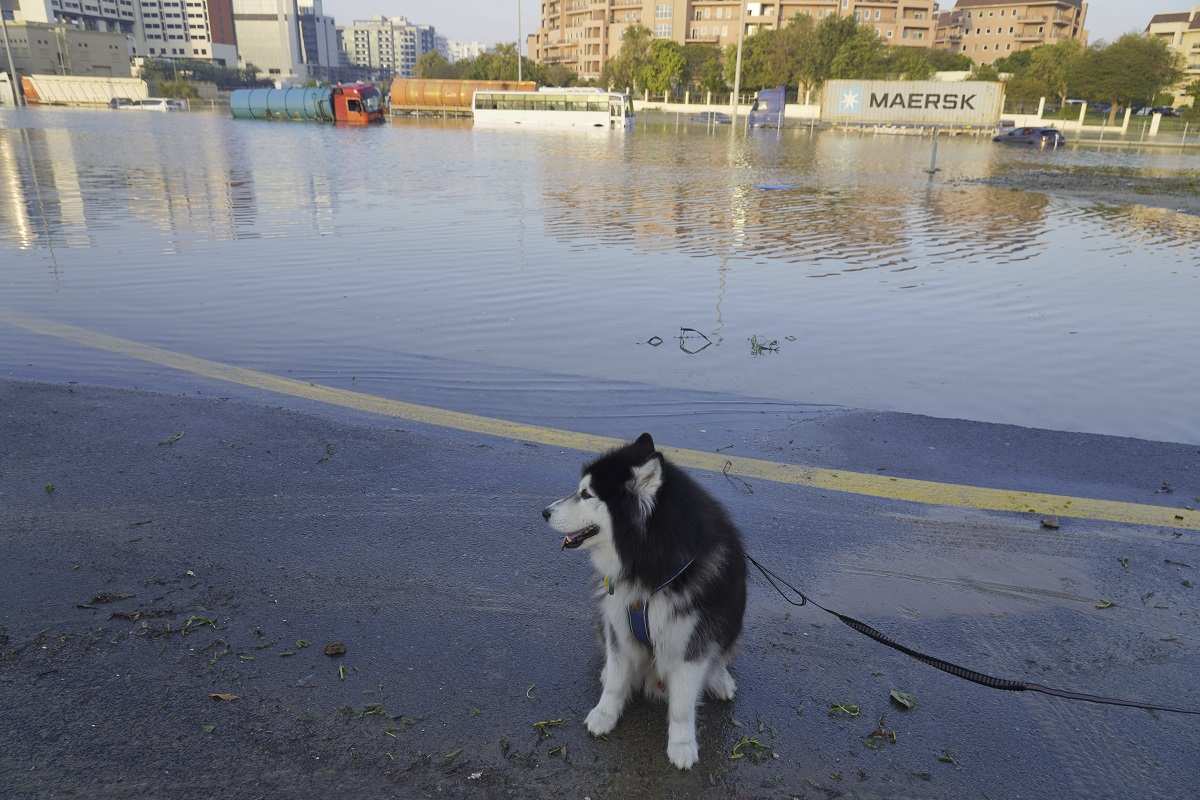United Arab Emirates Struggles to Recover after Heaviest Recorded Rainfall Ever Hits Desert Nation

Skye, a Husky dog, sits near floodwater in Dubai, United Arab Emirates, Thursday, April 18, 2024.
16:34 JST, April 18, 2024
DUBAI, United Arab Emirates (AP) — The United Arab Emirates struggled Thursday to recover from the heaviest recorded rainfall ever to hit the desert nation, as its main airport worked to restore normal operations even as floodwater still covered portions of major highways and roads.
Dubai International Airport, the world’s busiest for international travel, allowed global carriers on Thursday morning to again fly into Terminal 1 at the airfield.
“Flights continue to be delayed and disrupted, so we urge you to only come to Terminal 1 if you have a confirmed booking,” the airport said on the social platform X.
The long-haul carrier Emirates, whose operations had been struggling since the storm Tuesday, had stopped travelers flying out of the UAE from checking into their flights as they tried to move out connecting passengers. Pilots and flight crews had been struggling to reach the airport given the water on roadways. But on Thursday, they lifted that order to allow customers into the airport.
Others who arrived at the airport described hourslong waits to get their baggage, with some just giving up to head home or to whatever hotel would have them.
The UAE, a hereditarily ruled, autocratic nation on the Arabian Peninsula, typically sees little rainfall in its arid desert climate. However, a massive storm forecasters had been warning about for days blew through the country’s seven sheikhdoms.
By the end of Tuesday, more than 142 millimeters (5.59 inches) of rainfall had soaked Dubai over 24 hours. An average year sees 94.7 millimeters (3.73 inches) of rain at Dubai International Airport. Other areas of the country saw even more precipitation.
The UAE’s drainage systems quickly became overwhelmed, flooding out neighborhoods, business districts and even portions of the 12-lane Sheikh Zayed Road highway running through Dubai.
The state-run WAM news agency called the rain “a historic weather event” that surpassed “anything documented since the start of data collection in 1949.”
In a message to the nation late Wednesday, Emirati leader Sheikh Mohammed bin Zayed Al Nahyan, the ruler of Abu Dhabi, said authorities would “quickly work on studying the condition of infrastructure throughout the UAE and to limit the damage caused.”
On Thursday, people waded through oil-slicked floodwater to reach cars earlier abandoned, checking to see if their engines still ran. Tanker trucks with vacuums began reaching some areas outside of Dubai’s downtown core for the first time as well. Schools remain closed until next week.
Authorities have offered no overall damage or injury information from the floods, which killed at least one person.
“Crises reveal the strength of countries and societies,” Dubai’s ruler, Sheikh Mohammed bin Rashid Al Maktoum, wrote on X. “The natural climate crisis that we experienced showed the great care, awareness, cohesion and love for every corner of the country from all its citizens and residents.”
The flooding sparked speculation that the UAE’s aggressive campaign of cloud seeding — flying small planes through clouds dispersing chemicals aimed at getting rain to fall — may have contributed to the deluge. But experts said the storm systems that produced the rain were forecast well in advance and that cloud seeding alone would not have caused such flooding.
Jeff Masters, a meteorologist for Yale Climate Connections, said the flooding in Dubai was caused by an unusually strong low pressure system that drove many rounds of heavy thunderstorms.
Scientists also say climate change is responsible for more intense and more frequent extreme storms, droughts, floods and wildfires around the world. Dubai hosted the United Nations’ COP28 climate talks just last year.
Abu Dhabi’s state-linked newspaper The National in an editorial Thursday described the heavy rains as a warning to countries in the wider Persian Gulf region to “climate-proof their futures.”
“The scale of this task is more daunting that it appears even at first glance, because such changes involve changing the urban environment of a region that for as long as it has been inhabited, has experienced little but heat and sand,” the newspaper said.
"News Services" POPULAR ARTICLE
-

American Playwright Jeremy O. Harris Arrested in Japan on Alleged Drug Smuggling
-

Japan’s Nikkei Stock Average as JGB Yields, Yen Rise on Rate-Hike Bets
-

Japan’s Nikkei Stock Average Licks Wounds after Selloff Sparked by BOJ Hike Bets (UPDATE 1)
-

Japan’s Nikkei Stock Average Buoyed by Stable Yen; SoftBank’s Slide Caps Gains (UPDATE 1)
-

Japanese Bond Yields Zoom, Stocks Slide as Rate Hike Looms
JN ACCESS RANKING
-

Keidanren Chairman Yoshinobu Tsutsui Visits Kashiwazaki-Kariwa Nuclear Power Plant; Inspects New Emergency Safety System
-

Tokyo Economic Security Forum to Hold Inaugural Meeting Amid Tense Global Environment
-

Imports of Rare Earths from China Facing Delays, May Be Caused by Deterioration of Japan-China Relations
-

University of Tokyo Professor Discusses Japanese Economic Security in Interview Ahead of Forum
-

Japan Pulls out of Vietnam Nuclear Project, Complicating Hanoi’s Power Plans
























